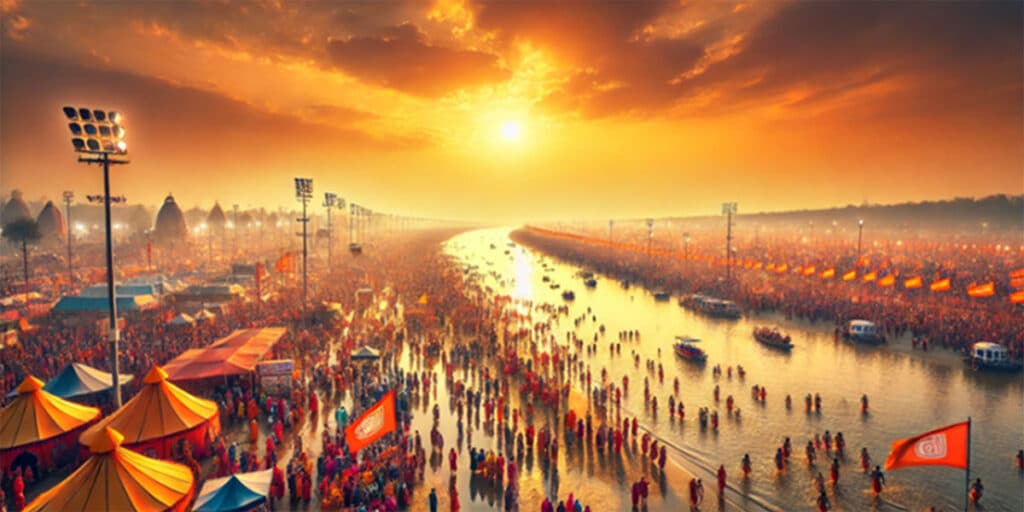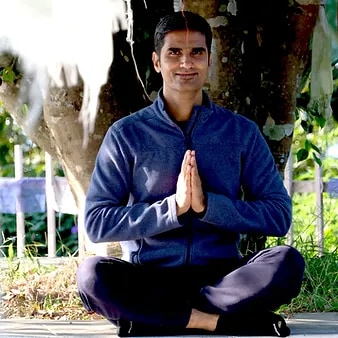Mahakumbh: A Spiritual Confluence of Faith and Tradition
by Hardik Mehta

The Mahakumbh, held every twelve years in India, is the world’s largest spiritual gathering and a profound testament to the nation’s rich cultural and religious heritage. This grand event draws millions of devotees, ascetics, spiritual seekers, and tourists from across the globe. Rooted deeply in Hindu mythology, the Mahakumbh is not just a festival but a spiritual awakening, offering a glimpse into India’s timeless traditions, rituals, and philosophies.
The Mythological Significance of the Mahakumbh
The origins of the Mahakumbh trace back to the ancient Hindu scriptures, the Puranas. According to legend, the gods and demons (Devas and Asuras) churned the cosmic ocean (Samudra Manthan) to obtain the nectar of immortality (Amrita). A fierce battle ensued over the nectar, and during this struggle, a few drops fell at four sacred locations: Prayagraj, Haridwar, Ujjain, and Nashik. These places became sanctified, and the Mahakumbh is celebrated at each of these locations in rotation.
The festival’s timing is determined by the alignment of celestial bodies. Astrologers meticulously calculate the most auspicious time based on the positions of the Sun, Moon, and Jupiter. This cosmic connection underscores the spiritual belief in the harmony between the universe and human existence.
The Spiritual Essence of the Mahakumbh
At its core, the Mahakumbh is a journey of self-purification and spiritual renewal. The primary ritual is the ‘Shahi Snan’ (Royal Bath), where millions take a holy dip in the sacred rivers, believing it washes away sins and liberates the soul from the cycle of birth and death (‘moksha’). This act is not merely a ritual but a profound spiritual experience that connects devotees to the divine.
The Mahakumbh serves as a melting pot of spiritual ideologies and practices. It is a confluence of saints, sadhus (holy men), and spiritual leaders who gather to share wisdom, perform rituals, and guide devotees on their spiritual paths. Akharas, or monastic orders, play a significant role in the festival, showcasing the diverse traditions within Hinduism.
Key Rituals and Activities
- Shahi Snan (Royal Bath): This is the highlight of the Mahakumbh. On specific auspicious dates, processions of saints and sadhus from various Akharas, adorned in vibrant attire and carrying their banners, proceed to the river for the holy dip. The sight is a visual spectacle that epitomizes devotion and grandeur.
- Satsangs and Discourses: The Mahakumbh is a hub for spiritual discourses, where revered gurus and scholars deliver talks on ancient scriptures, philosophy, and the path to enlightenment. These sessions provide invaluable insights into Hinduism’s spiritual teachings.
- Yagnas and Rituals: Fire sacrifices (‘yagnas’) and other Vedic rituals are performed to invoke blessings, purify the environment, and create a spiritual ambiance.
- Pilgrimage and Devotion: Many pilgrims walk barefoot for miles to reach the Mahakumbh, considering the journey itself as an act of penance and devotion. The energy of faith and collective consciousness is palpable, creating an environment charged with spirituality.
The Role of Sadhus and Saints
The Mahakumbh is synonymous with the presence of sadhus and ascetics, who live lives of renunciation and meditation. The Naga Sadhus, recognized for their ash-covered bodies and minimal attire, symbolize the detachment from material desires. Other sects, such as the Urdhwavahurs (those who practice severe penance) and Parivrajakas (wandering monks), also grace the festival, offering a unique glimpse into India’s spiritual diversity.
These ascetics are revered as spiritual guides, and their participation underscores the festival’s sanctity. For many devotees, interacting with these holy men provides inspiration and guidance on their spiritual journeys.
Spiritual Benefits of Participating in the Mahakumbh
- Inner Purification: The act of taking a holy dip is believed to cleanse the soul of sins, bringing peace and clarity.
- Collective Energy: The gathering of millions creates a collective spiritual energy that can uplift and inspire participants.
- Connection to Heritage: The rituals and practices offer a deep connection to India’s ancient spiritual traditions.
- Opportunities for Learning: The presence of saints and scholars makes the Mahakumbh a centre for spiritual education and growth.
The Global Appeal of the Mahakumbh
In recent years, the Mahakumbh has attracted international attention. Spiritual seekers from around the world come to witness and participate in this extraordinary event. The festival’s universal message of peace, unity, and spiritual awakening resonates across cultures and religions.
For global visitors, the Mahakumbh is an opportunity to experience India’s spiritual richness firsthand. From witnessing the vibrant processions to engaging in meditation and yoga sessions, the festival offers a transformative experience.
Challenges and Sustainability
Managing an event of this scale comes with significant challenges, including crowd management, sanitation, and environmental concerns. However, recent Mahakumbh events have seen remarkable advancements in planning and infrastructure. Authorities have implemented eco-friendly practices, efficient waste management systems, and technology-driven solutions to ensure a seamless experience for pilgrims.
How to Prepare for the Mahakumbh
For those planning to attend the Mahakumbh, preparation is key:
- Research: Understand the dates, location, and significance of the upcoming Mahakumbh.
- Accommodation: Book accommodations well in advance, as millions of pilgrims converge for the event.
- Health Precautions: Ensure vaccinations, carry necessary medications, and stay hydrated.
- Respect Traditions: Familiarize yourself with the rituals and practices to fully immerse in the experience.
The Mahakumbh as a Spiritual Beacon
In an era of rapid technological advancements and material pursuits, the Mahakumbh stands as a beacon of spirituality and tradition. It reminds us of the importance of introspection, faith, and the pursuit of higher truths. The festival’s timeless message—of unity amidst diversity and the eternal quest for spiritual enlightenment—resonates deeply in today’s world.
As the sacred rivers flow, carrying with them the hopes and prayers of millions, the Mahakumbh continues to inspire and transform. It is not just an event but a celebration of life, faith, and the infinite possibilities of the human spirit.
Attending the Mahakumbh is a journey into the heart of India’s spiritual soul. Whether as a devotee or an observer, the experience is bound to leave an indelible mark, inspiring a deeper connection to oneself and the universe. Truly, the Mahakumbh is a spiritual confluence like no other, a divine gathering that transcends time and space.
Learn more with us
Sayujya Yoga, with its deeply rooted Indian philosophy and holistic approach, offers transformative experiences through its 200-hour Teacher Training Courses (TTC). Whether you’re a beginner or a seasoned practitioner, Sayujya Yoga provides the perfect platform to deepen your practice and understanding of yoga.About the Author

Hardik Mehta
Hardik is an E-RYT 500 & YACEP (Yoga Alliance Continuing Education Provider), Yoga Alliance, USA. He has been practicing yoga for the last 9 years. Prior to finding his true calling in Yoga, he was working with various corporates for 12 years in the Retail and eCommerce sector.
